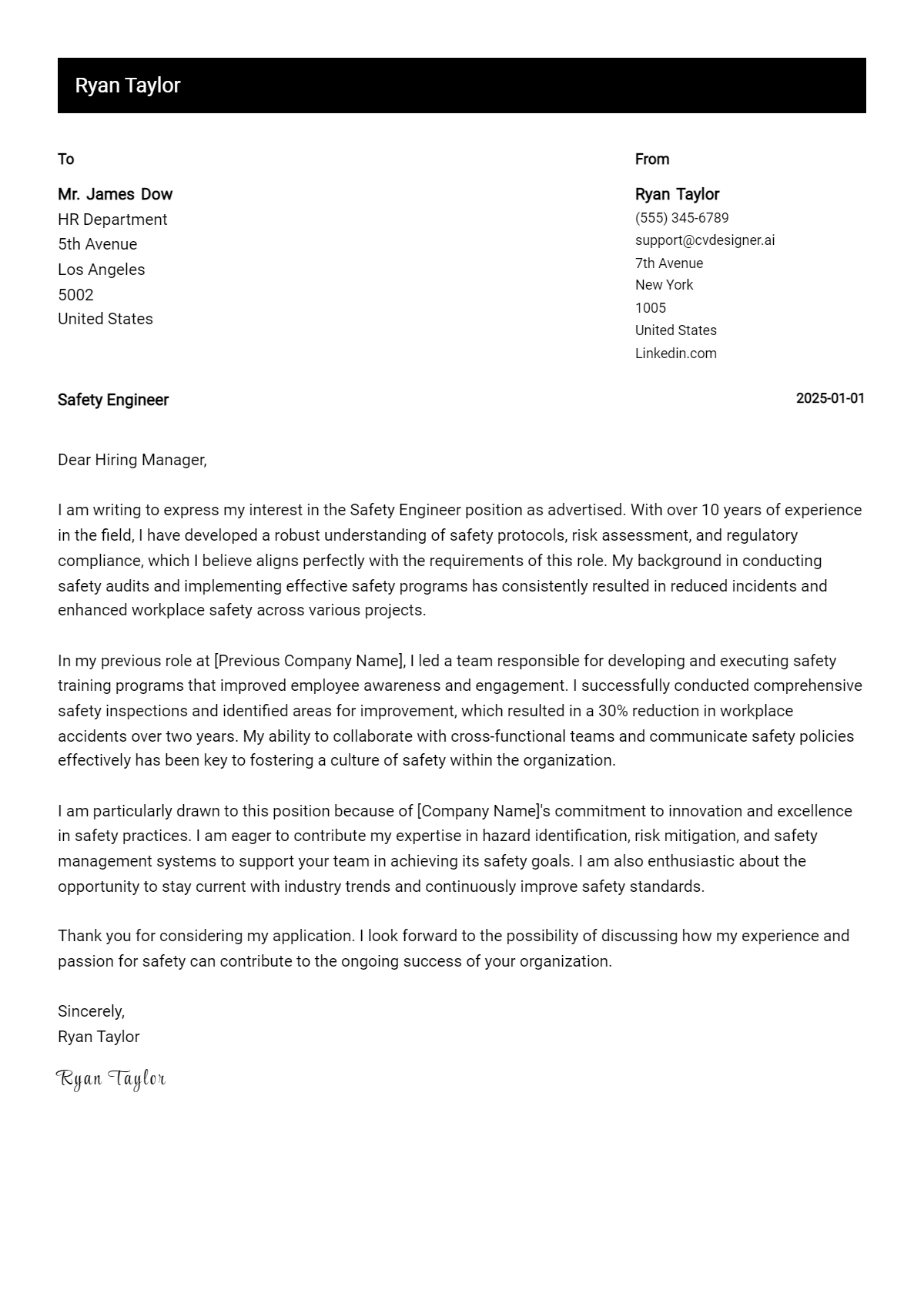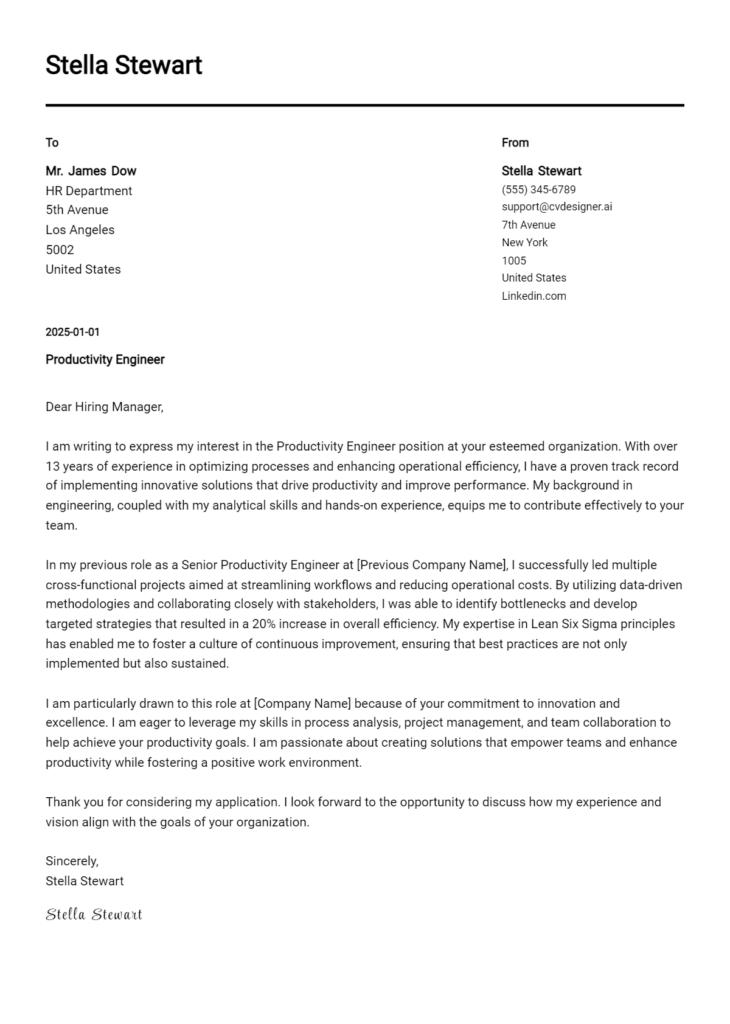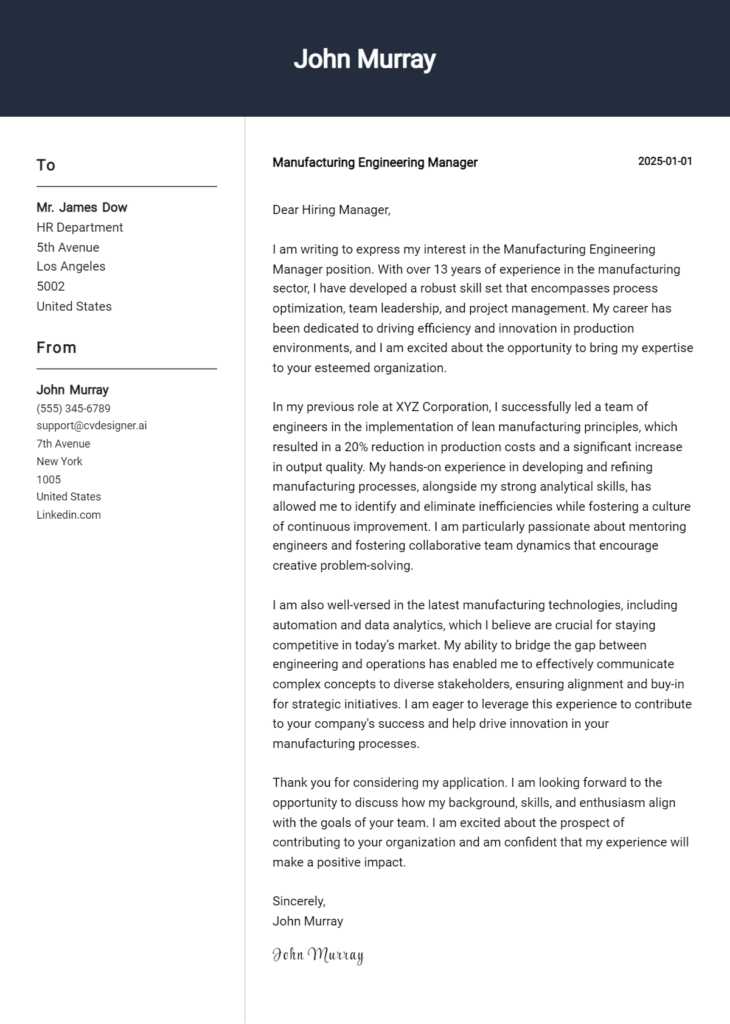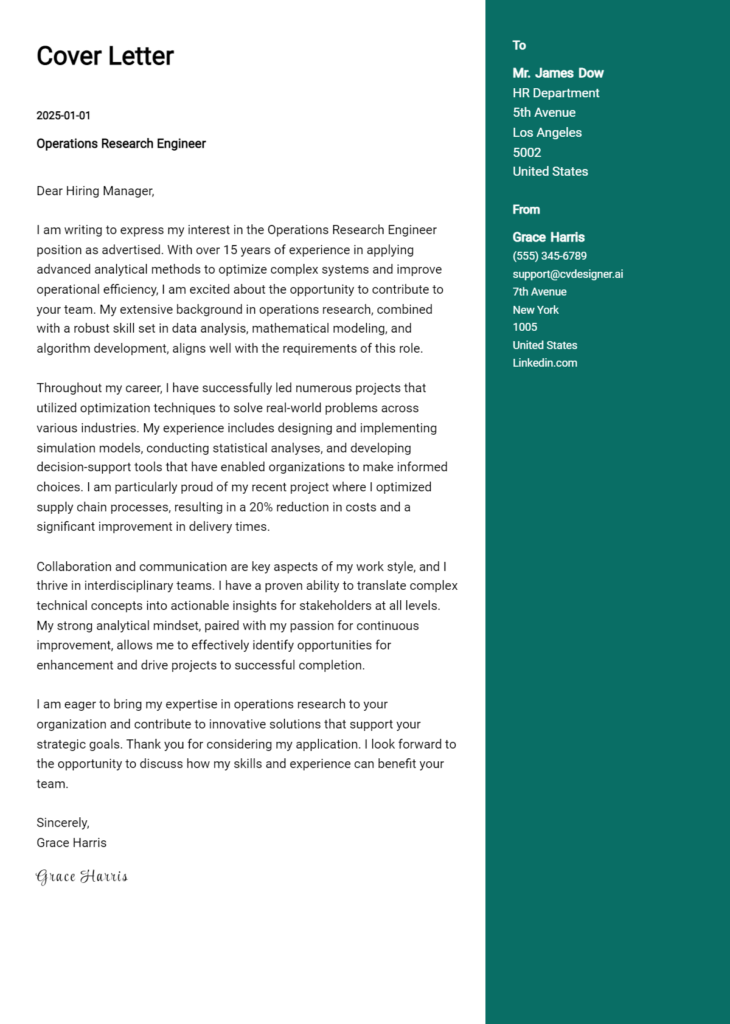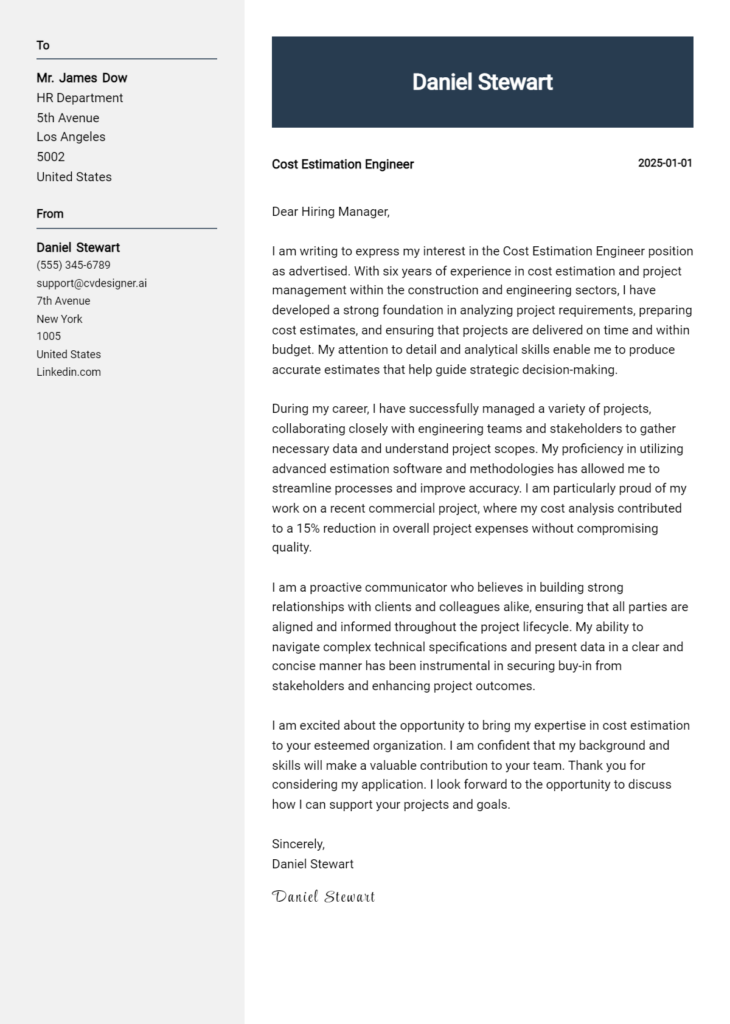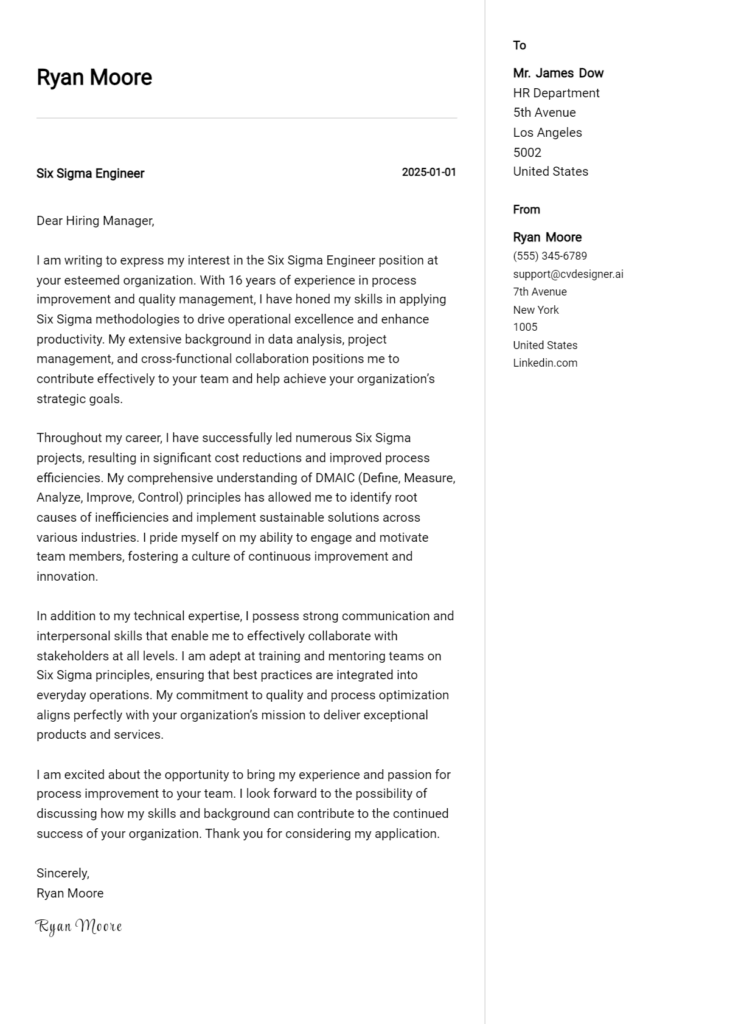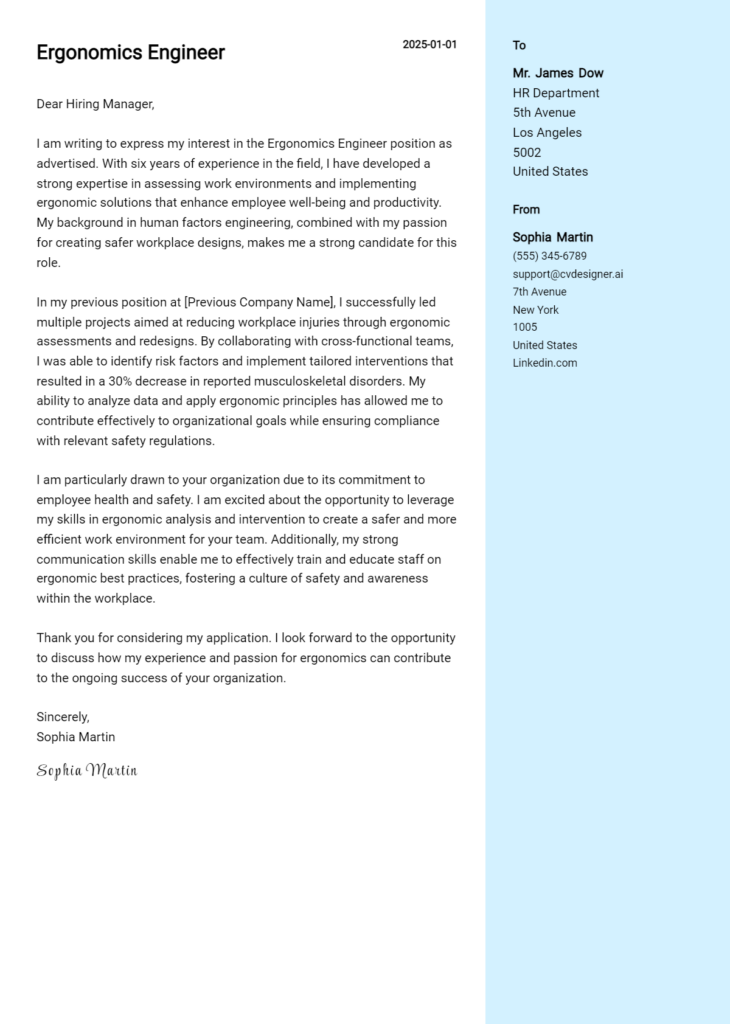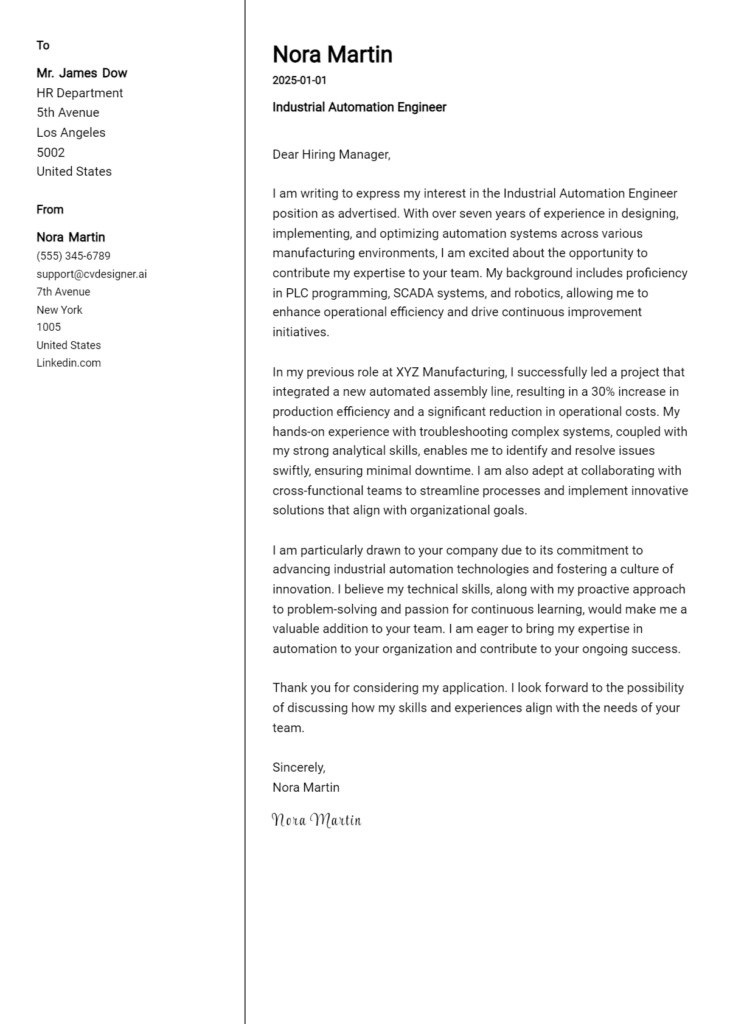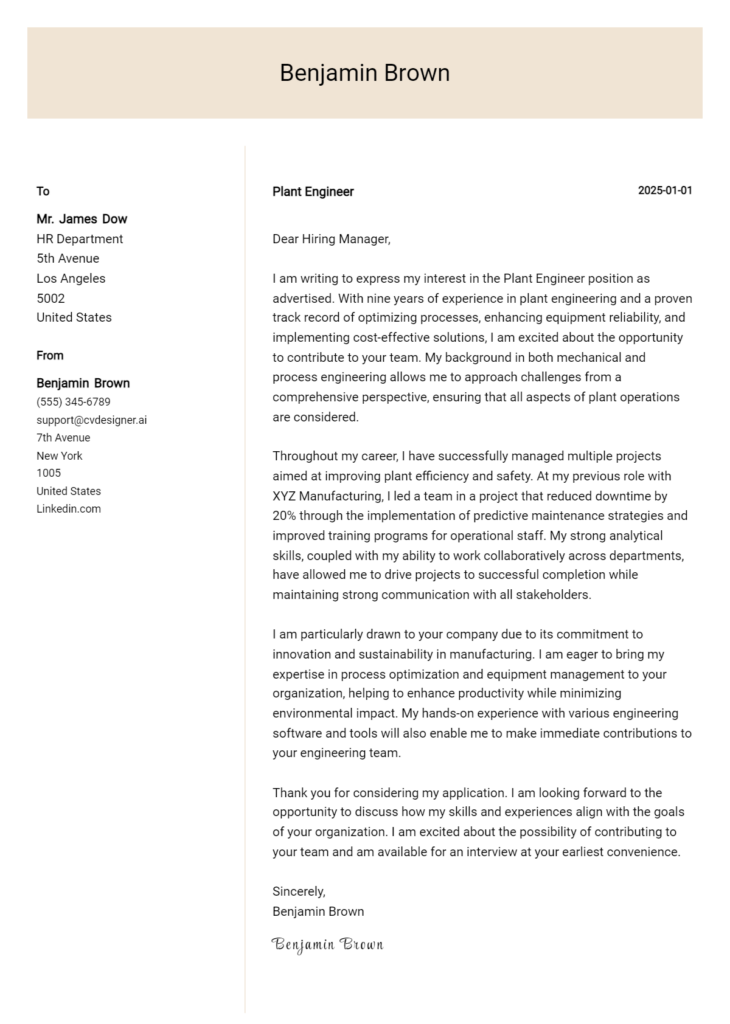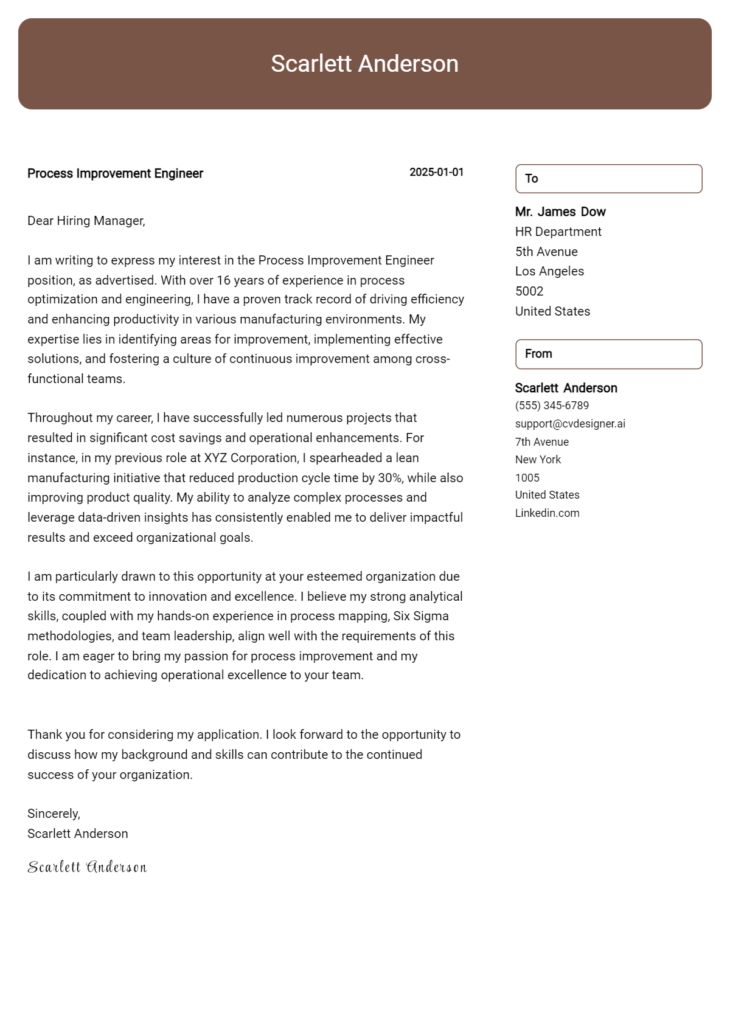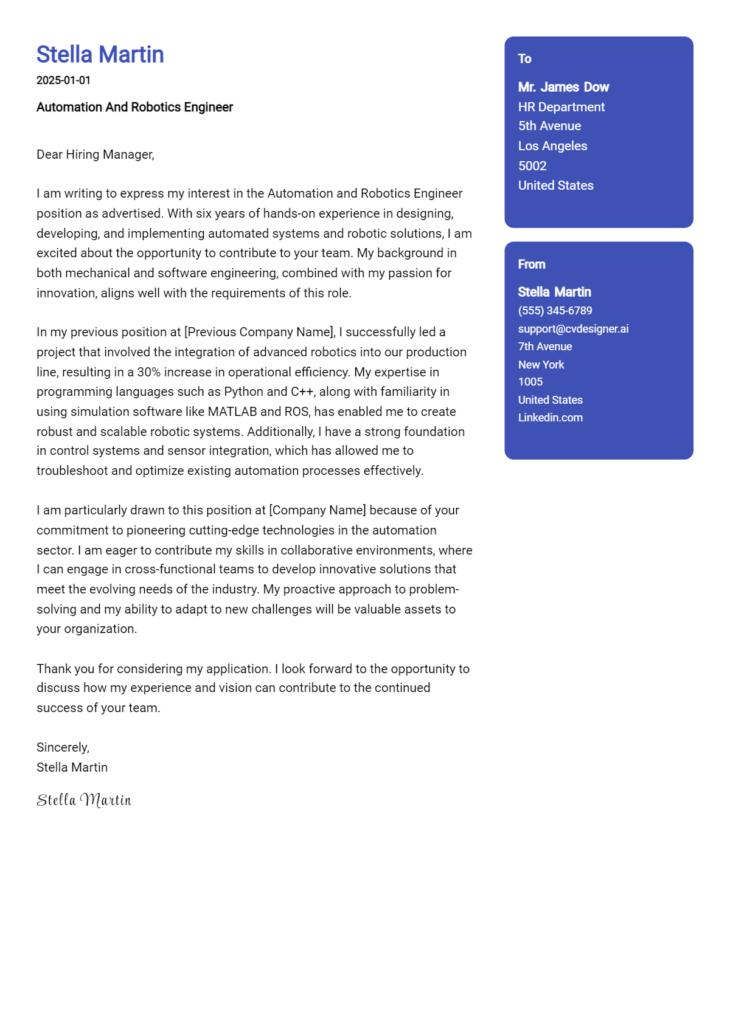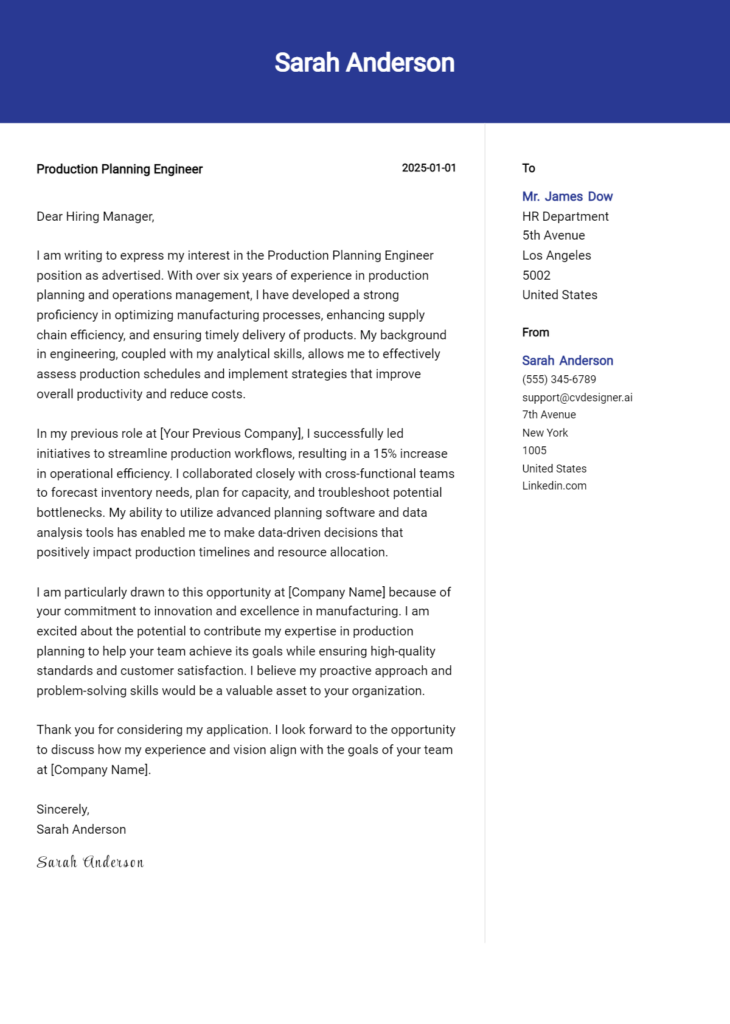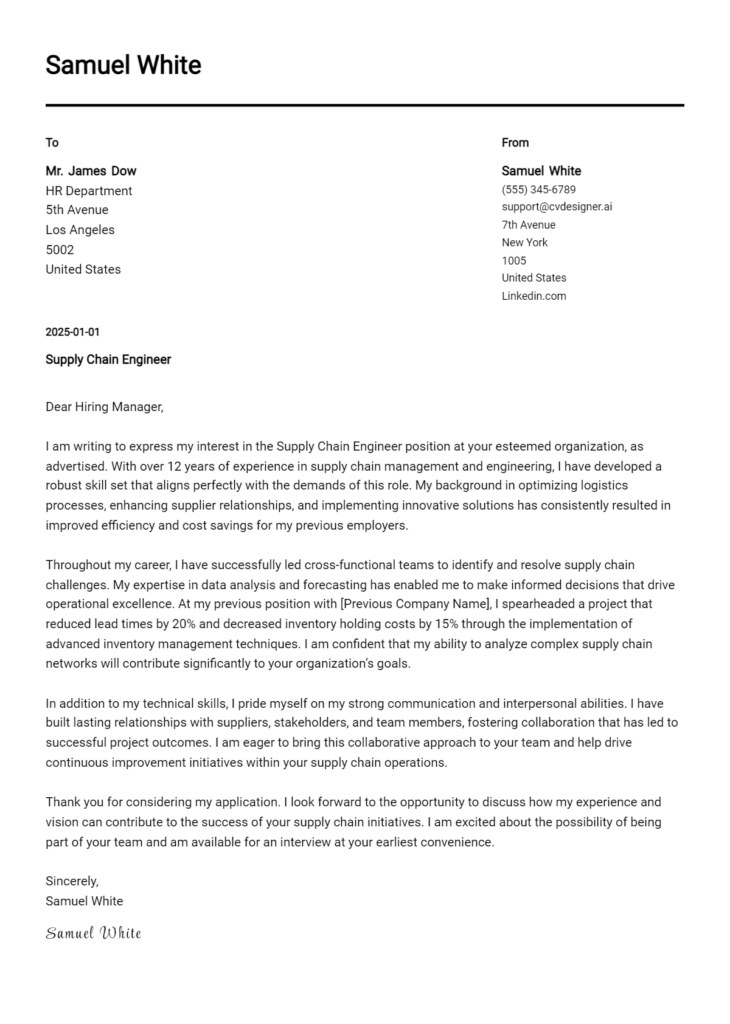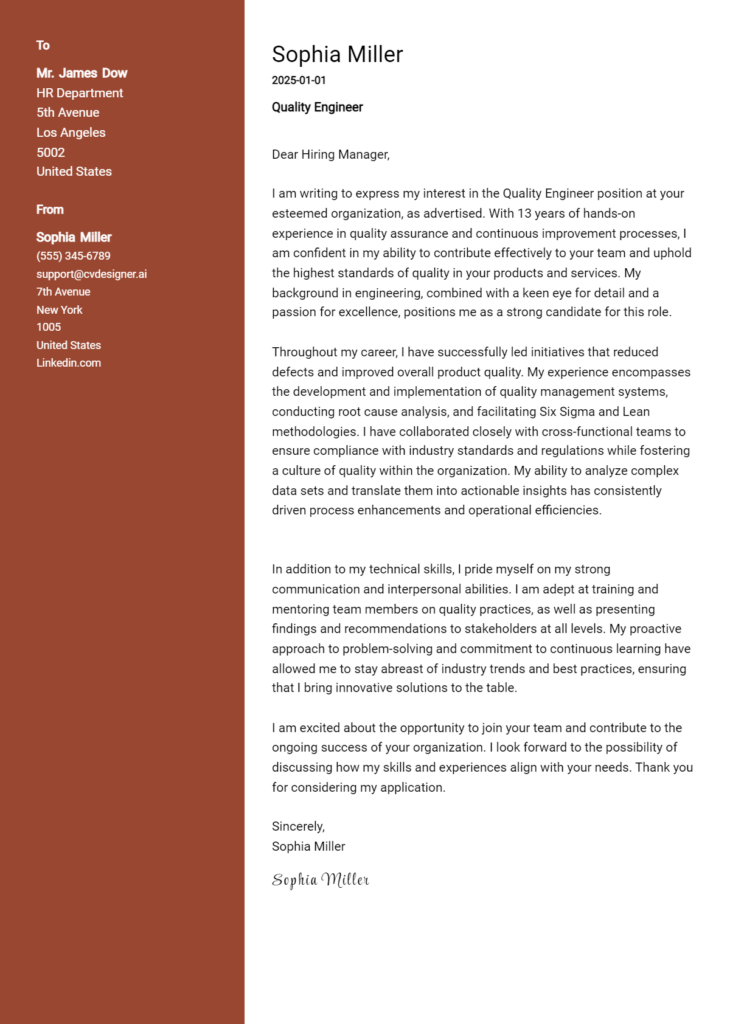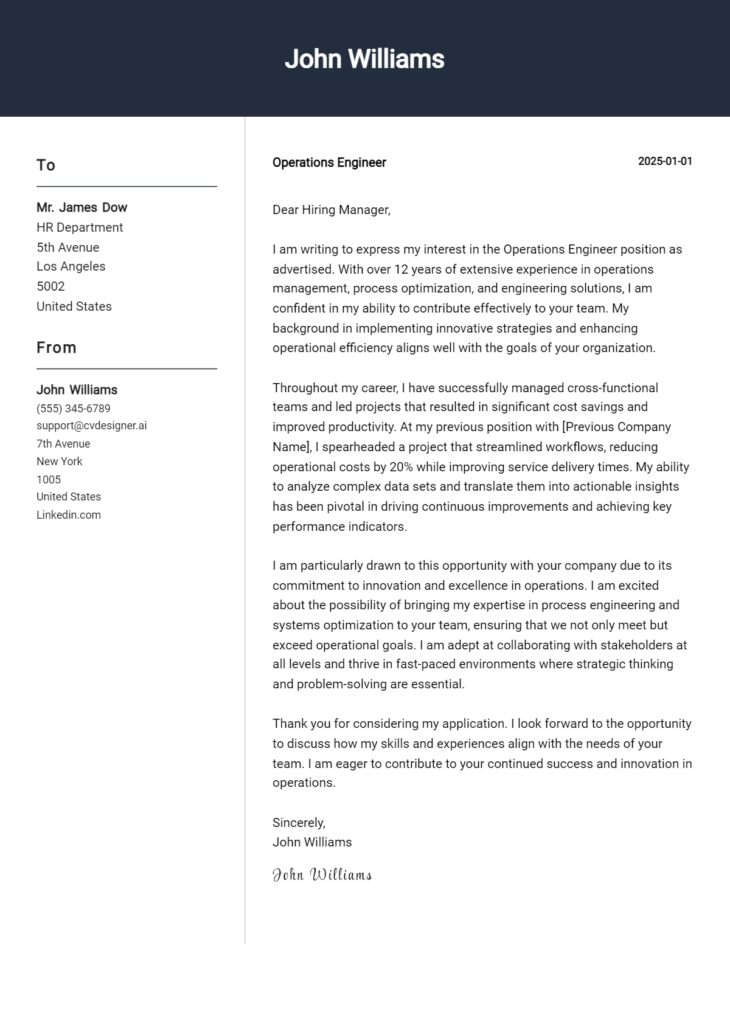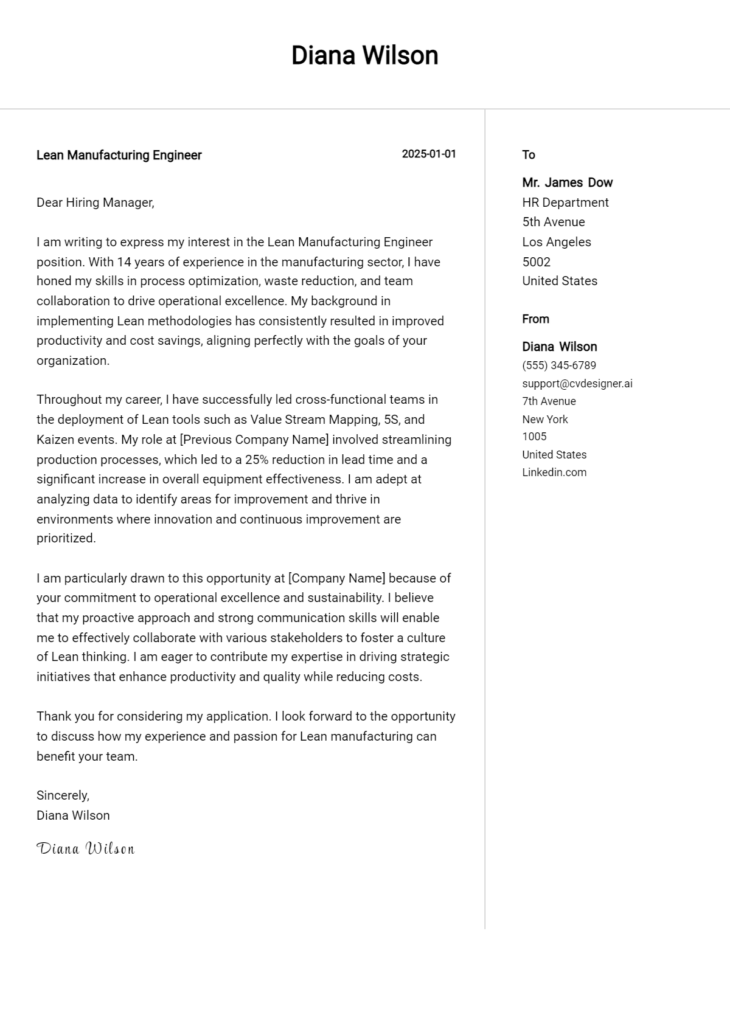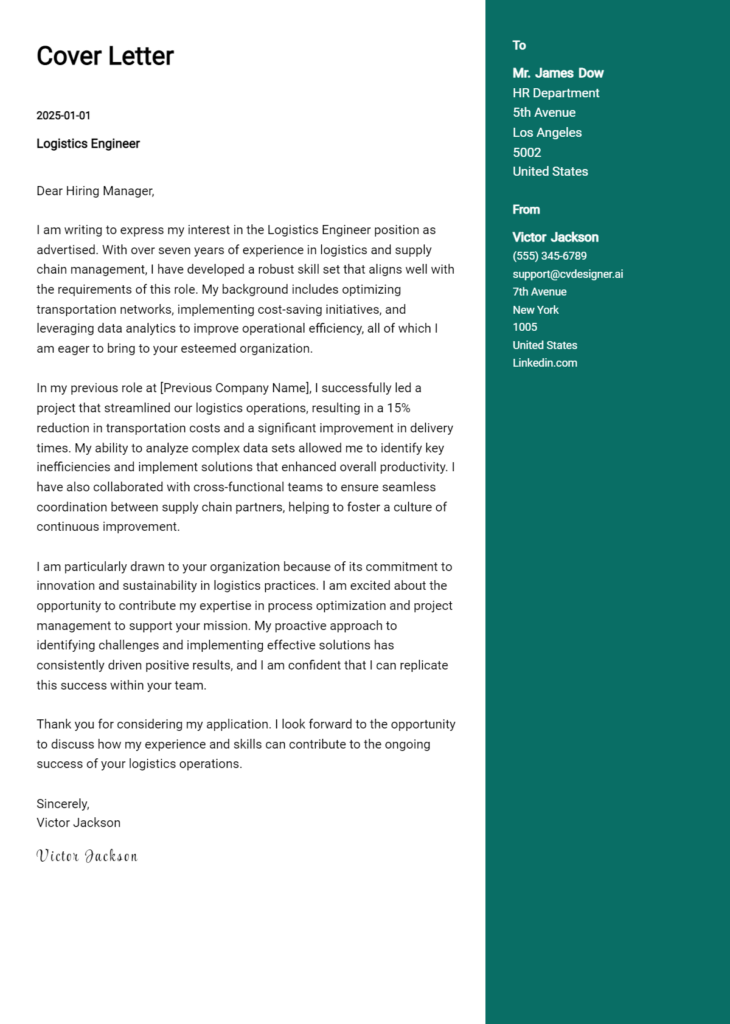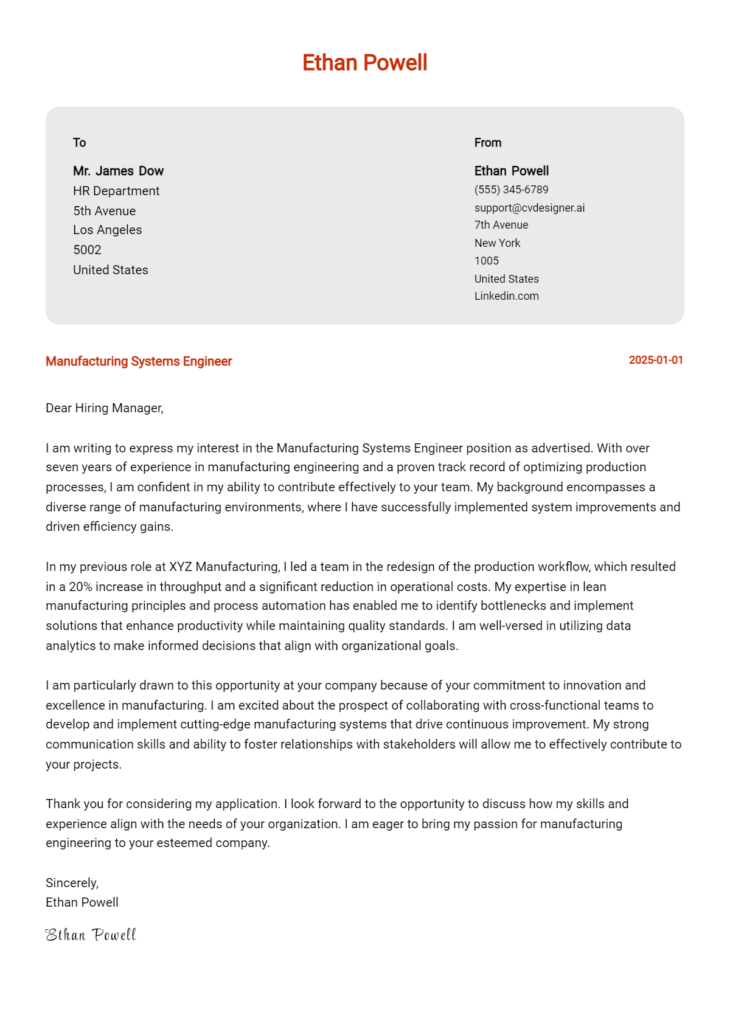Safety Engineer Cover Letter Examples
Explore additional Safety Engineer cover letter samples and guides and see what works for your level of experience or role.
How to Format a Safety Engineer Cover Letter?
Crafting an impactful cover letter is essential for a Safety Engineer, as it serves as your first opportunity to make a lasting impression on potential employers. The format of your cover letter not only conveys your qualifications and experience but also reflects your commitment to safety and attention to detail—attributes vital in the engineering field. A well-structured cover letter can effectively showcase your technical expertise and problem-solving skills, helping you stand out among other candidates.
In this guide, we'll explore how to structure your cover letter, providing insights and examples tailored specifically for Safety Engineers.
We will focus on the essential components of a professional cover letter, including:
- Cover Letter Header
- Cover Letter Greeting
- Cover Letter Introduction
- Cover Letter Body
- Cover Letter Closing
Each section is crucial in emphasizing your qualifications and professionalism. Let’s break down each part to help you create a compelling cover letter that aligns with your career in safety engineering.
Importance of the Cover Letter Header for a Safety Engineer
The cover letter header is a crucial element of your job application as a Safety Engineer. It sets the tone for the rest of your letter and provides essential information at a glance. A well-structured header includes your contact information, the date, and the recipient's details, ensuring clarity and professionalism. This not only makes it easier for the hiring manager to reach you but also reflects your organizational skills and attention to detail—qualities that are vital in a safety-focused role.
A strong header demonstrates your commitment to professionalism, while a weak header may leave a poor impression, potentially affecting your chances of getting an interview.
Strong Example
John Doe 123 Safety Lane Safety City, ST 12345 (123) 456-7890 john.doe@email.com October 15, 2023 Hiring Manager ABC Safety Solutions 456 Protection Ave Safety Town, ST 54321
Weak Example
john d. safety guy email123@gmail.com 10/15/23
The Importance of the Cover Letter Greeting
The greeting of your cover letter is crucial as it sets the tone for the entire document. A well-crafted greeting not only demonstrates your professionalism but also adds a personal touch by addressing the hiring manager directly. This initial connection can make a significant difference in how your application is perceived. To avoid sounding generic, take the time to research and find the recipient's name, which shows your genuine interest in the position and the company. A personalized greeting can help you stand out in a competitive job market, particularly for a specialized role like a Safety Engineer.
Strong Example
Dear Ms. Johnson,
Weak Example
To Whom It May Concern,
The Importance of a Well-Crafted Cover Letter Introduction for a Safety Engineer
A compelling cover letter introduction is crucial for a Safety Engineer as it sets the tone for the entire application. It should grab the hiring manager's attention immediately, express genuine interest in the position, and briefly highlight relevant skills or achievements that demonstrate why the candidate is a strong fit for the role. A well-articulated introduction can differentiate an applicant in a competitive job market, making it essential for candidates to invest time in crafting this vital section of their cover letter.
Strong Example
Dear [Hiring Manager's Name], I am excited to apply for the Safety Engineer position at [Company Name], where I aim to contribute my extensive experience in developing and implementing safety protocols that have reduced workplace incidents by 30% in my previous role. With a solid background in risk assessment and a commitment to fostering a culture of safety, I am eager to bring my expertise to your team and help ensure the highest safety standards in your operations.
Weak Example
To Whom It May Concern, I am writing to apply for the Safety Engineer job. I have some experience in safety and think I could do a good job. I hope to work for your company because it seems like a nice place to work.
Purpose of the Cover Letter Body for a Safety Engineer
The cover letter body for a Safety Engineer serves as a vital section where candidates can effectively communicate their qualifications, relevant experiences, and the unique value they bring to the company. This part of the cover letter should highlight specific projects or accomplishments that demonstrate the candidate's expertise in safety protocols, risk assessments, and compliance with regulations. By articulating these details, the candidate can create a compelling narrative that showcases their ability to enhance workplace safety and contribute to the organization's overall success.
Strong Example
I am excited to apply for the Safety Engineer position at ABC Corporation. In my previous role at XYZ Industries, I successfully led a project that implemented a new safety management system, which resulted in a 30% reduction in workplace accidents over a year. Additionally, I conducted comprehensive risk assessments that identified potential hazards, allowing the company to proactively address issues before they escalated. My commitment to fostering a culture of safety not only improved employee morale but also saved the company significant costs associated with accidents and insurance premiums. I am eager to bring my experience in developing safety protocols and my passion for ensuring compliance to the team at ABC Corporation.
Weak Example
I am applying for the Safety Engineer job. I have some experience in safety and have worked at a few different places. I think safety is important, and I would like to help your company to be safer. I have done some training and can follow rules. I hope you consider me for the position.
Importance of the Cover Letter Closing for a Safety Engineer
The closing paragraph of a cover letter is crucial for a Safety Engineer as it serves to summarize qualifications, reiterate interest in the position, and encourage the hiring manager to take the next step, such as reviewing the resume or scheduling an interview. A strong closing can leave a lasting impression and reinforce the candidate's fit for the role, while a weak closing may detract from the overall effectiveness of the letter. Below are examples of both strong and weak closing paragraphs:
Strong Example
In closing, I am enthusiastic about the opportunity to contribute my expertise in safety engineering to your esteemed organization. With a proven track record of implementing effective safety protocols and a commitment to fostering a safe work environment, I am confident in my ability to make a positive impact at [Company Name]. I look forward to the possibility of discussing how my skills and experiences align with your needs. Thank you for considering my application; I hope to speak with you soon to explore this opportunity further.
Weak Example
Thank you for reading my letter. I hope you look at my resume and consider me for the job. I guess I would be okay for the position. Let me know if you want to talk.
These tips will help candidates craft an effective cover letter for a Safety Engineer position, emphasizing the importance of showcasing technical skills, problem-solving abilities, knowledge of the Software Development Life Cycle (SDLC), teamwork, and a passion for continuous learning. A well-written cover letter can be the key to making a lasting impression on potential employers and securing an interview.
Tips for Writing a Cover Letter for a Safety Engineer
Highlight Technical Skills
Clearly outline your technical skills relevant to safety engineering, such as risk assessment, safety audits, and compliance with industry standards. Use specific examples from your experience to illustrate your proficiency. Consider incorporating metrics to quantify your achievements, demonstrating how your skills directly contributed to improving safety in previous roles.Demonstrate Problem-Solving Abilities
Safety engineers often face unexpected challenges that require quick thinking and effective solutions. Share a specific instance where you identified a safety issue and how you developed a strategy to resolve it. This narrative will showcase your analytical skills and ability to remain calm under pressure, both of which are critical in this field.Showcase Knowledge of SDLC
If applicable, discuss your understanding of the Software Development Life Cycle (SDLC) and how it relates to safety engineering. Mention any experience you have with integrating safety protocols into the development process, ensuring that safety is a priority from the initial design phase through to implementation and maintenance.Emphasize Teamwork and Collaboration
Safety engineering often requires collaboration across various departments. Use your cover letter to illustrate your experience working in teams, whether on safety initiatives, training programs, or cross-functional projects. Highlight your ability to communicate effectively and build relationships, which are essential for fostering a safety-conscious culture.Express a Passion for Continuous Learning
The field of safety engineering is constantly evolving, and showing your commitment to professional development is crucial. Mention any certifications, workshops, or training programs you have completed or plan to pursue that demonstrate your dedication to staying current with industry trends and best practices. This can help convey your proactive approach to enhancing your expertise.
For further assistance in crafting your cover letter, explore various cover letter templates or utilize a cover letter builder to streamline the writing process and create a polished document that stands out to employers.
Common Mistakes to Avoid in a Safety Engineer Cover Letter
Crafting a compelling cover letter is essential for standing out in the competitive field of safety engineering. Avoiding common mistakes can significantly enhance your chances of landing an interview. Here are some pitfalls to watch out for:
Generic Greetings: Using "To Whom It May Concern" can make your cover letter feel impersonal. Instead, research the hiring manager's name to create a personalized greeting.
Lack of Specific Examples: Failing to include specific examples of past achievements can weaken your letter. Highlight relevant experiences that demonstrate your skills in safety protocols and risk assessment.
Overly Technical Language: While you want to showcase your expertise, using jargon can alienate non-technical readers. Aim for clarity and accessibility in your writing.
Ignoring the Job Description: Not tailoring your cover letter to the specific job requirements can make it seem like you're sending a mass application. Reference key qualifications from the job posting.
Poor Formatting: A cluttered or unprofessional layout can detract from your message. Adhere to proper cover letter format principles to ensure readability.
Typos and Grammatical Errors: Mistakes in spelling or grammar can create a negative impression. Proofread your letter multiple times and consider using tools to catch errors.
Failure to Show Passion: A lack of enthusiasm for the role can be off-putting. Convey your passion for safety engineering and the specific organization in your letter.
By steering clear of these common missteps, you can create a more impactful cover letter that showcases your qualifications effectively. For additional inspiration, check out these cover letter examples.
Cover Letter FAQs for Safety Engineer
What should I include in my cover letter for a Safety Engineer position?
In your cover letter for a Safety Engineer role, it's crucial to highlight your relevant qualifications and experiences. Start with a brief introduction that states your interest in the position and the company. Include specific examples of your hands-on experience with safety protocols, risk assessments, and compliance with safety regulations. Mention any certifications, like OSHA or NEBOSH, that enhance your credibility. Discuss your ability to conduct safety audits and your experience in developing safety training programs. Finally, convey your passion for creating a safe work environment and your commitment to continuous improvement in safety practices.
How can I demonstrate my technical skills in the cover letter?
To effectively showcase your technical skills in the cover letter, use concrete examples that illustrate your expertise. Describe specific projects or initiatives where you applied your knowledge of safety engineering principles, such as hazard analysis, safety management systems, or emergency response planning. Use metrics wherever possible; for instance, mention how your interventions reduced incidents by a certain percentage or improved compliance rates. Additionally, highlight your proficiency with safety management software or tools that are relevant to the industry. This approach not only illustrates your technical abilities but also shows potential employers how you can add value to their organization.
How do I tailor my cover letter for a specific Safety Engineer job?
Tailoring your cover letter for a specific Safety Engineer job involves researching the company and understanding the job description thoroughly. Identify the key competencies and skills mentioned in the job listing, and align your experiences with those requirements. For instance, if the job emphasizes expertise in a particular safety standard, mention your experience with that standard and how you applied it in previous roles. Personalizing your cover letter also means addressing the hiring manager by name, if possible, and expressing why you are drawn to that particular organization. This demonstrates your genuine interest and can make your application stand out.
What tone should I use in my cover letter as a Safety Engineer?
The tone of your cover letter as a Safety Engineer should strike a balance between professionalism and approachability. Use clear, concise language that conveys your technical expertise without being overly complex. Avoid jargon that may not be understood by all readers, especially if the cover letter is reviewed by HR personnel. Maintain a confident yet humble tone; express your achievements and skills while showing a willingness to learn and collaborate with others. Additionally, convey your passion for safety and commitment to fostering a safe workplace. This combination will help create a strong first impression on potential employers.
Build your Cover Letter in minutes
Use an AI-powered cover letter builder and have your letter done in 5 minutes. Just select your template and our software will guide you through the process.

